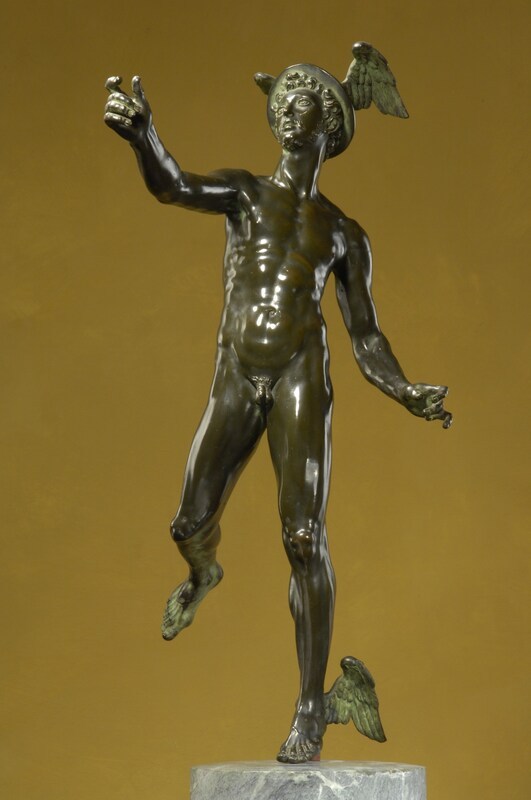Master Work City
Elias Holl is one of the most important German architects of the 17th century. His name is associated with the radical transformation of Augsburg. Created in the span of just one human lifetime, Holl's buildings continue to shape Augsburg's urban form as an unmistakable historical legacy to this day. It can be considered his work. On the occasion of the 450th anniversary of Holl's birth, who was the city's master builder from 1602 to 1630 and from 1632 to 1635, his work and his time are highlighted in the exhibition.
Following the exhibitions of 1946 (300th anniversary of his death, Schaezlerpalais), 1973 (400th anniversary, Holbeinhaus) and 1985 (City Hall, Golden Hall and two Fürstenzimmer), this is now the fourth exhibition of the city in honour of its former master craftsman, now staged in the Maximilianmuseum. The current exhibition is curated by Dr Christoph Emmendörffer, the director of the Maximilianmuseum.

From the town hall
model into the
Golden Hall
A flight through Holl's second centre gable model to the new town hall: from planning to finished construction.
Holl's life - mirror
of contemporary history
Holl's life and work coincide with a period of unique flourishing of art and science in Augsburg. At that time, the imperial city was one of the most important metropolises in Central Europe in terms of economy, art and science. The city was one of the leading metropolises in Central Europe. People looked with self-confidence at a history that went back to antiquity and the prominent position as an imperial city in the "Holy Roman Empire". Holl's life is a mirror of contemporary history, especially of the extraordinary development of his father city, which suffered greatly from the upheavals of the 30 Years' War.
Like the majority of Augsburg's inhabitants, Holl was a Protestant and deeply religious. In 1630, he sacrificed his highly respected and very well paid position as city works master for his Protestant faith.

Hubert Gerhard, Flying Mercury, bronze, c. 1590. Gerhard, creator of the Augustus Fountain, made the statuette for the city's master builder Wolfgang Paler the Younger © Munich, Bayerisches Nationalmuseum
About the person
Elias Holl
Unlike many other German artists and master builders of the early Baroque period, we can form a picture of the personality of Augsburg's Stadtwerkmeister not only from the surviving buildings, but above all from the many surviving written sources, including Holl's autobiography, the so-called Hauschronik. Holl was an outstanding master builder and civil engineer whose expertise as an expert and also as an architect was in demand far beyond Augsburg. He distinguished himself through enormous diligence and was not so modest as to conceal this. He was a "man of conviction" in his field - always looking for the best result.

Lucas Kilian, Portrait engraving of Elias Holl, 1619 © Kunstsammlungen & Museen Augsburg, Maximilianmuseum
Elias Holl
and his familiy
Elias Holl's wives played an important role in his life: out of love for his first wife Maria Burkhart, he renounced the journeyman's hike. In his two marriages, to Rosina Reischle and Maria Burkhart, he had a total of 21 children. Holl included his children on official occasions such as the laying of the foundation stone for the new town hall or when he put the tower button on the Perlach tower. He also attached great importance to the education of his sons and the good marriages of his daughters.

Elias Holl, Model of the scaffolding for the Perlachturm, Augsburg, 1614/1615; Maximilianmuseum Augsburg - The model shows Holl's unique construction for raising the height of the Perlachturm and for transporting the council bells in the tower's newly built belfry. © Kunstsammlungen & Museen Augsburg
334 objects on view
With unique exhibits - architectural models, plans, drawings, prints, handicrafts and paintings - the current exhibition paints a vivid picture of Augsburg's famous master builder, his era and his aftermath. The entire Maximilianmuseum, including the models of the town hall, is included in the exhibition. A total of 334 objects are on display, including valuable loans such as a lavabo set (pot and basin) from the Augsburg art cabinet for King Gustav II Adolph of Sweden from the Gustavianum Museum, Uppsala University.
Picture gallery >>>
The town hall model
Elias Holl's second centre gable model for the new town hall, created in 1614. This is Holl's final design for the new town hall building, which is then also approved by the town governors.
Erlösung -
A Graphic Novel
Accompanying the exhibition is a graphic novel entitled "Erlösung. Augsburg im Dreißigjährigen Krieg". It deals with a dramatic chapter in Augsburg's history: the liberation of the Protestant citizenry by King Gustavus Adolphus of Sweden in April 1632. The Swedish king confronted the imperial city with a choice: surrender without a fight or perish. The diary of the Augsburg art agent Philipp Hainhofer (1578-1647) served as the source.
The graphic novel is the first comprehensive pictorial account of this exciting chapter in Augsburg's history. Christoph Emmendörffer researched the historical background and translated the early modern text into modern German. Paul Rietzl did the drawings and the storyboard. It is available in the museum shop for 39.90 euros.
Many thanks to the arts et studium foundation for their financial support of the project.

Please note:
For conservation reasons, some rooms in the exhibition are heavily cooled.
Photography is prohibited in the exhibition.
Many thanks for the support of:













MAXIMILIANMUSEUM
Fuggerplatz 1
D-86150 Augsburg
T +49 821 324 41 67 (Checkout/Shop)
Imprint:
City of Augsburg
Kunstsammllungen und Museen Augsburg
Director: Dr. Christof Trepesch
Strategic Communication: Monika Harrer-Jalsovec M.A.
Curator of the exhibition: Dr. Christoph Emmendörffer
Exhibition graphics: KW N9UN
Editor: Simone Eitzenberger M.A.
Picture credits: Kunstsammlungen & Museen Augsburg and as indicated.

